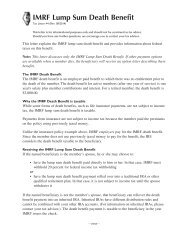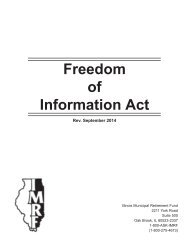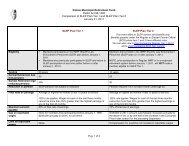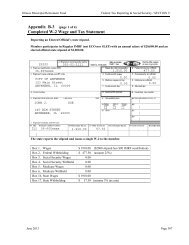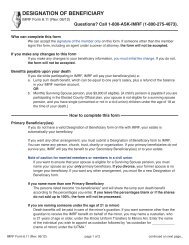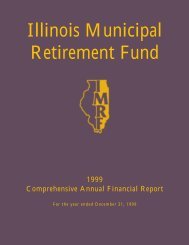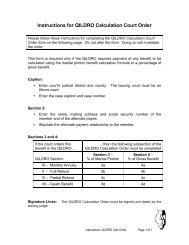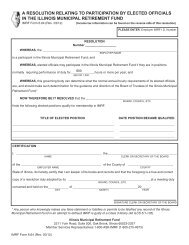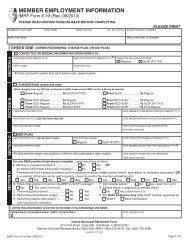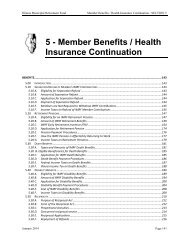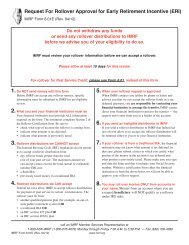SLEP Tier 2 Plan - IMRF
SLEP Tier 2 Plan - IMRF
SLEP Tier 2 Plan - IMRF
Create successful ePaper yourself
Turn your PDF publications into a flip-book with our unique Google optimized e-Paper software.
Table of ContentsBenefits at a Glance................................................................................ 2Participation in <strong>IMRF</strong>Membership in <strong>SLEP</strong>............................................................... 4Member ContributionsWhat you contribute to <strong>IMRF</strong>............................................... 7Making additional contributions to <strong>IMRF</strong>............................ 9Refunds of member contributions...................................... 10Service CreditWhat is service credit........................................................... 13Purchasing or converting service credit.............................. 14Working for two <strong>IMRF</strong> employers at the same time......... 15Converting unused, unpaid sick days to service credit...... 16Service in other Illinois public pension funds..................... 18Retirement BenefitsYour Final Rate of Earnings................................................. 19Qualifying for a <strong>SLEP</strong> pension............................................. 20Your pension amount.......................................................... 21Applying for your pension................................................... 22Pension payment options.................................................... 23Annual increases and “13th payment”.............................. 25Pension estimate chart......................................................... 26If you return to work after you retire................................ 28Disability Benefits................................................................................. 29Death Benefits....................................................................................... 33If you divorce......................................................................................... 40Social Security........................................................................................ 41Health Insurance Continuation............................................................ 42Your <strong>IMRF</strong> member account................................................................. 44Questions .............................................................................................. 45<strong>IMRF</strong> Administration............................................................................. 46Dictionary of terms............................................................................... 47
MEMBERSHIP IN <strong>SLEP</strong>In addition, in those counties that have adopted the Sheriffs’ MeritCommission Act, your appointment must be made from the list certifiedby the Merit Commission. Part-time, auxiliary, or special deputies maynot participate in the <strong>SLEP</strong> plan.Chief DeputyIf you are a chief deputy in a full-time position, whether or not yourposition is exempted from coverage by a Merit Commission, you mustparticipate in <strong>IMRF</strong> under the <strong>SLEP</strong> plan.DeputyIf you are a full-time deputy and you meet the qualifications listedabove, you will participate in <strong>IMRF</strong> under the <strong>SLEP</strong> plan even thoughyou may be designated as a bailiff, desk sergeant, etc.However, if you are a bailiff or desk personnel and you are notdeputized by the legally required method, you are not eligible for <strong>SLEP</strong>;you will participate in <strong>IMRF</strong>’s Regular plan.Correctional OfficersIf you are a correctional officer working in a full-time position anddeputized as a regular deputy—and if required are certified by a MeritCommission—you will participate in <strong>IMRF</strong> under the <strong>SLEP</strong> plan.Forest Preserve District RangersForest Preserve District Commissions have the option of providingthe <strong>SLEP</strong> plan to their law enforcement officers employed on afull-time basis.If you are a forest preserve law enforcement officer, commonlyreferred to as a forest ranger, you will participate in <strong>IMRF</strong>’s Regularplan unless your commission adopts the <strong>SLEP</strong> plan.www.imrf.org <strong>SLEP</strong> <strong>Tier</strong> 2 5
MEMBERSHIP IN <strong>SLEP</strong>Airport PoliceIf you are an airport police officer, you will participate in <strong>IMRF</strong> ifyour police duties are full-time and you are not eligible to participate ina local police pension plan.Airport authorities have the option of providing the <strong>SLEP</strong> plan totheir full-time police officers. You will participate in <strong>IMRF</strong>’s Regularplan unless your airport authority adopts the <strong>SLEP</strong> plan.Police ChiefsIf you are a police chief, you may be entitled to participate in <strong>IMRF</strong>as a <strong>SLEP</strong> member. If you currently participate in a local police pensionplan and are employed by an <strong>IMRF</strong> employer, you have the option ofenrolling in <strong>SLEP</strong>.If you are eligible to participate in <strong>SLEP</strong>, you may also transferservice as a police officer from a local police pension plan into <strong>SLEP</strong>.If you are a newly hired police chief, you may participate in <strong>SLEP</strong>without first joining your local police pension fund. To do so, you mustenroll in <strong>IMRF</strong> within the first three months of your appointment aspolice chief or within three months of the formation of a new policepension fund.Once you elect to become a <strong>SLEP</strong> member, you remain a <strong>SLEP</strong>member as long as you perform police duties for any <strong>IMRF</strong> employer.Police chiefs not eligible for <strong>SLEP</strong>The following police chiefs are not eligible to join <strong>SLEP</strong>:• Police chiefs with <strong>IMRF</strong> municipalities that do not have a localpolice pension plan and are not required by law to form one (under5,000 population).• Police chiefs with <strong>IMRF</strong> municipalities that have a police pensionplan, but the chief chose not to enroll in the plan during theeligibility period.• Police chiefs with municipalities that do not participate in <strong>IMRF</strong>.• Acting, temporary, interim, deputy, or any position other than anappointed police chief.6<strong>SLEP</strong> <strong>Tier</strong> 2 www.imrf.org
MEMBER CONTRIBUTIONSWhat do you contribute to <strong>IMRF</strong>?Your member contributionsAs a member of <strong>IMRF</strong> making contributions toward a <strong>SLEP</strong> pension,you contribute 7.50% of your salary: 3.75% for your Regular planpension, 3% for the additional <strong>SLEP</strong> retirement benefit, and 0.75% for asurviving spouse pension.You do not make any contributions on wages above the wage cap. In2011, the cap is $106,800. You also do not make any contributions onwages earned as a result of overtime. Read more about wage caps onpage 19.Your contributions are tax-deferred; you do not pay either federal orIllinois income tax on the money used to make your contributions. Yourcontributions will be subject to federal income tax, but not to Illinoisincome tax, when you receive them as a refund or as a pension or whenyour beneficiary(ies) receives them as a death benefit.This tax-deferred treatment of your contributions is provided underthe 414(h) tax deferral plan effective July 1, 1984, for all <strong>IMRF</strong>employers and adopted earlier by some employers.If you made contributions before your employer adopted a 414(h)plan, those contributions were taxed at the time you made them. Theyare not taxable when you receive them as a refund or pension or whenyour beneficiary(ies) receives them as a death benefit.Please note: You cannot borrow from your membercontributions or use them as collateral for a loan. Yourcontributions cannot be garnished or seized by anycreditor. As long as your contributions remain on depositwith <strong>IMRF</strong>, they are protected from your creditors.www.imrf.org <strong>SLEP</strong> <strong>Tier</strong> 2 7
EMPLOYER CONTRIBUTIONSYour employer’s contributionsYour employer’s contributions are not credited to individual memberaccounts. An employer’s contribution consists of:• A portion of the pension costs for its members who reachretirement and for survivors’ pensions• All costs for the Supplemental Benefit Payment (“13th payment”)• All of the costs for disability benefits• All of the costs for death benefitsReturns on <strong>IMRF</strong>’s investments typically account for thelargest contributor to fund retirement benefits. For everydollar paid in a pension, on average only 27 cents comesfrom employers (taxpayers).8<strong>SLEP</strong> <strong>Tier</strong> 2 www.imrf.org
MAKING ADDITIONAL contributions TO <strong>IMRF</strong>You can increase your retirement savings by making additionalcontributions to <strong>IMRF</strong>. You may contribute up to an additional 10%of your salary (up to the wage cap) to <strong>IMRF</strong>’s Voluntary AdditionalContribution (VAC) program. At retirement, your VAC may be taken as alump sum or as an additional monthly pension.Your VAC are after tax—they are not tax-deferred like your usual<strong>IMRF</strong> member contributions. Some members may be better served bycontributing a portion of their salary on a pre-tax (tax-deferred) basis totheir employer’s deferred compensation plan, e.g., 457 or 403(b).Earning interest on your VACUnlike VAC themselves, the interest credited to your VAC accountis tax-deferred. The interest rate paid is currently 7-1/2%. This interestrate can change in the future. If the interest rate changes, <strong>IMRF</strong> will notnotify VAC participants of the change.VAC interest is credited differently from a traditional savings account:• A traditional savings account credits interest on the current amountin the account.• <strong>IMRF</strong> credits interest at the end of the year on the beginning ofthe year amount. Therefore, you will not earn any interest the firstyear you begin making VAC.Although you can apply for a refund of your VAC at anytime, <strong>IMRF</strong>discourages such refunds. If you are seeking a short-term savings vehicle,voluntary additional contributions may not be the right choice.To begin making VAC, submit <strong>IMRF</strong> Form 6.30, “Election to MakeVoluntary Additional Contributions.” Deductions begin as soon as <strong>IMRF</strong>receives your application and your employer begins reporting your VACto <strong>IMRF</strong>.www.imrf.org <strong>SLEP</strong> <strong>Tier</strong> 2 9
REFUNDS OF MEMBER CONTRIBUTIONSWhen can you take a refund?For members participating in <strong>SLEP</strong> <strong>Tier</strong> 2If you stop working for your <strong>IMRF</strong> employer and have:Less than 10 years of <strong>SLEP</strong> and/or Regular service*Your 7.50% <strong>SLEP</strong> contributions will be returned to you uponrequest.10 or more years of <strong>SLEP</strong> serviceLess than age 50 — Your 7.50% <strong>SLEP</strong> contributions will bereturned to you upon request. However, you will be givingup the right to a future pension.Age 50 or older — You cannot withdraw your contributions;you will receive them as a part of your monthly pension.Exception: you can receive a refund only if you will roll itover into another defined benefit retirement plan to purchasequalifying service credit.* If you have any previous Regular <strong>Tier</strong> 1 service, you will be eligible for a Regular<strong>Tier</strong> 1 pension at age 55 if your total <strong>IMRF</strong> service credit equals or exceeds eightyears. See bottom of page 20.How to apply for a refundTo apply for a refund, submit <strong>IMRF</strong> Form 5.10, “Application forSeparation Refund.” Federal tax law does not allow <strong>IMRF</strong> to pay arefund if you stop participating in <strong>IMRF</strong> but continue working foryour same employer.When you take a refund of your <strong>IMRF</strong> contri butions, youforfeit—give up—all of your <strong>IMRF</strong> benefits. You willnot be eligible for any retirement or disability benefit,and your beneficiary(ies) will not be entitled to any deathbenefit.10<strong>SLEP</strong> <strong>Tier</strong> 2 www.imrf.org
REFUNDS OF MEMBER CONTRIBUTIONSFederal withholding on all refunds<strong>IMRF</strong> is required by federal law to withhold 20% of the taxableportion of your refund unless you elect to have the taxable portiondirectly rolled over to an IRA or other qualified retirement plan.Depending on your age, you may also be liable for an additional10% tax on the taxable amount. You may avoid the additional10% tax on the refund by directly rolling your refund into an IRAor other qualified pension plan.Repaying a refund(Redeposit of withdrawn contributions)If you stop working for your <strong>IMRF</strong> employer and take a refund ofyour contributions, you may redeposit those withdrawn contributions(repay the refund) and reinstate your years of service credit.To do so, you must return to work in a position that participates in:• <strong>IMRF</strong> or in a reciprocal retirement system, you can repay therefund after participating for two years• <strong>IMRF</strong> <strong>SLEP</strong>, you can repay the refund after working enough hoursto meet your employer’s <strong>IMRF</strong> hourly standard (either 600 or1,000 hours).You would complete and submit <strong>IMRF</strong> Form 6.03, “Application forReinstatement of Service Credit.” You may redeposit the withdrawncontributions, plus interest, either in a lump sum or installments.Refunds paid at retirementYou can receive a retirement refund in a lump sum or as an additionalretirement annuity.Refund of voluntary additional contributionsIf you have voluntary additional contributions on deposit when youretire, you can receive the voluntary additional contributions and interestin a lump sum or as an additional monthly annuity. The additionalmonthly annuity is payable for life.www.imrf.org <strong>SLEP</strong> <strong>Tier</strong> 2 11
REFUNDS OF MEMBER CONTRIBUTIONSRefund of <strong>SLEP</strong> contributionsIf you do not qualify for a <strong>SLEP</strong> <strong>Tier</strong> 2 pension when you retire, butyou do qualify for a Regular <strong>Tier</strong> 1 pension, your <strong>SLEP</strong> contributions(currently 3%) will be refunded with interest. You can receive thecontributions in a lump sum or as an additional monthly annuity.Refund of surviving spouse contributionsIf you do not have an eligible spouse when you retire (you were notmarried or in a civil union for at least one year before you terminated<strong>IMRF</strong> participation), <strong>IMRF</strong> will refund your surviving spousecontributions, with interest.If your spouse is not eligible for a surviving spouse pension, you canprovide him or her with a benefit which is similar to a surviving spousepension by electing a Special Needs annuity at retirement. See page 23.Converting a retirement refund into a monthly annuity• A retirement refund cannot be converted into a monthly annuitypayment unless the monthly payment is at least $10 a month.• You cannot convert part of a retirement refund to an annuity.• The additional monthly annuity will be paid for your lifetime.There is no annual increase, and this annuity is not eligible for thesupplemental benefit payment (“13th payment”).• The original lump sum amount is the guaranteed minimum payout.There is no maximum payout.Contributions not received as a benefitUpon your death, if <strong>IMRF</strong> has not returned all of your membercontributions to you as either a refund or as a pension and a survivingspouse pension is not payable, your beneficiary(ies) will receive anybalance in your member account (member contributions plus interestless any benefits paid).12<strong>SLEP</strong> <strong>Tier</strong> 2 www.imrf.org
WHAT IS SERVICE CREDITWhat is service credit?Service credit is your total time under <strong>SLEP</strong>, stated in years andmonths. Your years and months of service credit partially determine theamount of your <strong>IMRF</strong> pension. (See page 21.) <strong>SLEP</strong> service with morethan one <strong>SLEP</strong> employer is combined.Service is credited monthly while you are working, receiving <strong>IMRF</strong>disability benefits, or while you make member contributions during an<strong>IMRF</strong> Benefit Protection Leave.You earn one month of <strong>SLEP</strong> service credit for each month you:• Work in a <strong>SLEP</strong> qualified position and make a <strong>SLEP</strong> membercontribution*• Receive an <strong>IMRF</strong> disability benefit (you receive disability servicecredit)• Are on an <strong>IMRF</strong> Benefit Protection Leave** (BPL) of Absence(you receive BPL service credit, limited to 12 months)• Purchase past service credit*If your wages exceed the wage cap, you will not make a member contribution;however, you will continue to earn service credit.**If your employer wishes to provide you with <strong>IMRF</strong> service credit and <strong>IMRF</strong>disability and death benefit protection while you are taking a leave of absence,your employer’s governing body would grant and file with <strong>IMRF</strong> an <strong>IMRF</strong>Benefit Protection Leave, <strong>IMRF</strong> Form 6.32. To be eligible for disability anddeath benefits, Form 6.32 must be filed before the disability or death occurs.For more information, refer to “Purchasing <strong>IMRF</strong> Past Service Credit” in themember area of the <strong>IMRF</strong> website, www.imrf.org.www.imrf.org <strong>SLEP</strong> <strong>Tier</strong> 2 13
PURCHASING SERVICE CREDITEnhancing your pensionby purchasing additional service creditConverting Regular service to <strong>SLEP</strong>Some <strong>SLEP</strong> members may be eligible to convert up to 10 years ofRegular plan service credit to <strong>SLEP</strong> service credit.If you are not vested for a <strong>SLEP</strong> <strong>Tier</strong> 2 pension (have at least 10 yearsof <strong>SLEP</strong> service), converting your Regular plan service may allow youto vest for a <strong>SLEP</strong> pension.To determine your costs to convert your Regular service and to learnif you are eligible, complete <strong>IMRF</strong> Form 6.09, “Conversion of RegularService Credit to <strong>SLEP</strong> Service Credit.” You can download Form 6.09from www.imrf.org.Converting/purchasing other serviceYou may be eligible to receive or purchase other service credit, e.g., you:• Took a refund of your <strong>IMRF</strong> contributions. You want to pay backthe refund and reinstate your service.• Worked in a position that qualified for <strong>IMRF</strong>, but your employerdid not enroll you in <strong>IMRF</strong>.• Wish to convert time served in the military to <strong>IMRF</strong> service.• Were working for your employer when it joined <strong>IMRF</strong>. You weregranted the maximum free service (20% of your service up to fiveyears) and wish to purchase your remaining service.• Are an elected official who held an office qualifying for <strong>IMRF</strong>. Younow participate in <strong>IMRF</strong> and wish to purchase previous electedofficial service.• Have service credit with a public pension system in another stateand wish to convert it to <strong>IMRF</strong> service credit.• Will take a leave of absence from your job. While on leave,you want to earn <strong>IMRF</strong> service credit and you want your <strong>IMRF</strong>disability and death protection to continue.For more information, refer to “Purchasing <strong>IMRF</strong> Past ServiceCredit” in the Member area of the <strong>IMRF</strong> website, www.imrf.org.14 <strong>SLEP</strong> <strong>Tier</strong> 2 www.imrf.org
WORKING FOR TWO EMPLOYERS AT THE SAME TIMEConcurrent serviceWorking for two <strong>IMRF</strong> employers at the same timeMembers who work for two or more <strong>IMRF</strong> employers at the sametime have “concurrent” service. Concurrent service occurs when amember is reported by more than one employer for the same month.However, by law, the member is eligible for only one month of servicecredit.If your employers report you under the same plan (e.g., <strong>SLEP</strong>),you earn one month of service credit and your salaries from all positionsare combined (up to the wage cap) for that month. If the concurrentservice occurs during your “final rate of earnings” period (see page 19),it can increase the amount of your pension.If your employers report you under the Regular and <strong>SLEP</strong>plans, you earn one month of service credit but your salaries from thepositions are not combined. If you continue to be reported under Regularand <strong>SLEP</strong> and you earn 10 or more years of <strong>SLEP</strong> service credit, eachconcurrent month will be treated as a month of service in two plans: onemonth Regular and one month <strong>SLEP</strong>. When your pension is calculated,the calculation will apply the Regular pension formula to those monthswith Regular wages and the <strong>SLEP</strong> pension formula to those months with<strong>SLEP</strong> wages.www.imrf.org <strong>SLEP</strong> <strong>Tier</strong> 2 15
CONVERTING SICK DAYS TO SERVICE CREDITWhat happens to your unused, unpaid sick days?You may qualify for a maximum of one year (240 days) of additionalservice credit for unused, unpaid sick days earned with your lastemployer.You earn one month of service credit for every 20 days of unused,unpaid sick leave or fraction thereof. For example:Unused, unpaid Additional monthssick daysof service credit1-20 1 month21-40 2 months41-60 3 months61-80 4 months101-120 6 monthsetc. up to 221-240 days1 yearTo convert the sick days to service credit, the sick days must meetcertain criteria. You must not have received compensation of any kind—including payment of amounts less than your regular salary—for the sickleave. And the sick leave must have been accumulated under a writtenplan established by your employer and available to all employees or to aclass of employees.16<strong>SLEP</strong> <strong>Tier</strong> 2 www.imrf.org
CONVERTING SICK DAYS TO SERVICE CREDITThis additional service credit applies:• If you are leaving employment for retirement. The sick leave musthave been earned under an established sick leave plan available toall employees or a class of employees, and the effective date of yourpension must be within 60 days of your last day of participation in<strong>IMRF</strong>.• If a member dies while participating in <strong>IMRF</strong> and a survivingspouse pension is payable. Because a surviving spouse pensionis based on the pension the deceased member had earned, <strong>IMRF</strong>includes unused, unpaid sick days when calculating a survivingspouse pension (see page 38).Please note: converted sick leave service credit cannotbe used to meet the 10-year requirement for a <strong>SLEP</strong><strong>Tier</strong> 2 pension.www.imrf.org <strong>SLEP</strong> <strong>Tier</strong> 2 17
SERVICE IN OTHER ILLINOIS PUBLIC PENSION SYSTEMSWhat is reciprocal service credit?<strong>IMRF</strong> is under the Reciprocal Act, as are all other Illinois publicpension systems except local police and fire pension funds. Under theReciprocal Act, service credit in other Illinois public pension systemsmay be combined at the date of retirement or death. The total of yourcombined service is then used to determine your eligibility for benefitsand the amount of those benefits.To be eligible to retire under the Reciprocal Act, you need• At least 12 months of service in each system and• The total amount of your service credit with all retirement systemsmust meet or exceed the vesting requirements of each system.You would receive a separate pension payment from each retirementsystem.Applying for a reciprocal pensionThe best way to apply for a reciprocal pension is to apply with all ofyour reciprocal systems at the same time.You need to submit separate pension applications with each systemyou participated in. Most importantly, be sure to tell each system thatyou are applying for a reciprocal pension. For more informationon the Reciprocal Act and reciprocal pensions, you can download theReciprocal Act booklet from the member publications area ofwww.imrf.org.Please note: Reciprocal service cannot be used in thecalculation of a <strong>SLEP</strong> pension. Under <strong>SLEP</strong> <strong>Tier</strong> 2, youneed 10 years of <strong>SLEP</strong> service credit to qualify for a<strong>SLEP</strong> pension.18<strong>SLEP</strong> <strong>Tier</strong> 2 www.imrf.org
HOW YOUR SALARY DETERMINES YOUR PENSIONYour final rate of earnings (FRE)Under <strong>SLEP</strong> <strong>Tier</strong> 2, your final rate of earnings (FRE) is your highesttotal earnings (up to the wage cap and excluding overtime wages) duringany 96 consecutive months within your last 10 years of <strong>IMRF</strong> servicedivided by 96. Usually, this is the average of the last 96 months of service.Simple FRE calculationTo calculate this <strong>IMRF</strong> member’s FRE at retirement, the last eightyears (96 months) are used because his earnings were highest in the last96 consecutive months:July 2020 to June 2021 . . . . . . . $62,629July 2019 to June 2020 . . . . . . . $60,805July 2018 to June 2019 . . . . . . . $59,034July 2017 to June 2018 . . . . . . . $57,315July 2016 to June 2017 . . . . . . . $55,645July 2015 to June 2016 . . . . . . . $54,024July 2014 to June 2015 . . . . . . . $52,451July 2013 to June 2014 . . . . . . . $50,923July 2012 to June 2013 . . . . . . . $49,440July 2011 to June 2012 . . . . . . . $48,000Highest 96 monthsTotal of last 96 consecutive months:8 year total = $452,826Divided by 96 = $4,717This member’s FRE = $4,717Wage capsUnder <strong>Tier</strong> 2, a member’s wages are capped at $106,800 (in 2011).You do not pay any contributions on wages above the cap. The wage capis also applied when <strong>IMRF</strong> calculates your benefits. The cap increaseseach year by the lesser of 3% or one-half of the increase in the ConsumerPrice Index (urban) for the preceding September. If the CPI is zero, thewage cap is not increased.Under <strong>SLEP</strong> <strong>Tier</strong> 2, wages earned as a result of overtime arenot included as <strong>IMRF</strong> wages. You do not pay any contributions onovertime wages.www.imrf.org <strong>SLEP</strong> <strong>Tier</strong> 2 19
QUALIFYING FOR A PENSIONHow do you qualify for a <strong>SLEP</strong> <strong>Tier</strong> 2 pension?• You must have at least 10 years of <strong>SLEP</strong> <strong>Tier</strong> 2 service credit.• You must not be working in any position which qualifies for <strong>IMRF</strong>participation.• You must be at least age 50.– If you retire between age 50 and 55, your pension will bereduced by 1/2% for each month you are under age 55.– If you retire at 55 or older, your pension will not be reduced.Please note: the following service cannot be countedtoward the 10-year requirement for a <strong>SLEP</strong> pension:• Unused, unpaid sick days converted to service credit• Regular service credit (not converted to <strong>SLEP</strong>)• Illinois Reciprocal Retirement System service• Service credit in a local police pension plan• Federal law enforcement serviceIf you retire with <strong>SLEP</strong> <strong>Tier</strong> 2 service plus other <strong>IMRF</strong> service*• If you retire with 10 or more years of <strong>SLEP</strong> <strong>Tier</strong> 2 service creditplus other Regular service, you will receive a <strong>SLEP</strong> <strong>Tier</strong> 2 pensionplus a Regular plan pension.• If you retire with less than 10 years of <strong>SLEP</strong> <strong>Tier</strong> 2 service creditbut have other Regular service:– Regular <strong>Tier</strong> 1 and <strong>SLEP</strong> <strong>Tier</strong> 2Eight or more years of total service, your service will be combinedto determine a Regular <strong>Tier</strong> 1 pension. Your <strong>SLEP</strong> contributionswill be refunded with interest.– Regular <strong>Tier</strong> 2 and <strong>SLEP</strong> <strong>Tier</strong> 210 or more years of total service, your service will be combined todetermine a Regular <strong>Tier</strong> 2 pension. Your <strong>SLEP</strong> contributions willbe refunded with interest.*You can convert up to 10 years of Regular plan service to <strong>SLEP</strong>. See page 14.20<strong>SLEP</strong> <strong>Tier</strong> 2 www.imrf.org
CALCULATING YOUR PENSIONHow is your pension calculated?Your pension is based on your final rate of earnings (FRE) and youryears of <strong>IMRF</strong> service credit. Your <strong>IMRF</strong> pension is paid as long asyou live.<strong>SLEP</strong> pension formulaThe <strong>SLEP</strong> pension formula applies only to <strong>SLEP</strong> members with 10or more years of <strong>SLEP</strong> service. The <strong>SLEP</strong> pension formula is 2.50% ofyour final rate of earnings for each year of <strong>SLEP</strong> service creditFor example:After earning Your <strong>SLEP</strong> pension would equal*10 years of service...................25% of final rate of earnings15 years of service................37.5% of final rate of earnings20 years of service...................50% of final rate of earnings25 years of service................62.5% of final rate of earnings30 years of service...................75% of final rate of earningsThe total pension at retirement cannot exceed 75% of your final rateof earnings.Estimating the amount of your future pension• Pension estimate chart—turn to page 26.• Estimate using your current <strong>IMRF</strong> member information—visitMember Access at www.imrf.org (see page 44).• Formal pension estimate—call 1-800-ASK-<strong>IMRF</strong>(1-800-275-4673). We recommend you request a formal estimate ifyou are within five years of retirement.*Assumes retirement at age 55 or older.www.imrf.org <strong>SLEP</strong> <strong>Tier</strong> 2 21
applying for your pensionHow to apply for your pension<strong>IMRF</strong>’s Member Retirement <strong>Plan</strong>ning Checklist, available fromwww.imrf.org, can help you stay on track with your retirement planning.One month before you plan to retire, submit <strong>IMRF</strong> Form 5.20,“Application for Retirement Annuity.” <strong>IMRF</strong> will contact you if youneed to submit copies of the documents listed on the application.If you have service credit with any of the 12 reciprocal retirementsystems in Illinois, please refer to page 18.<strong>IMRF</strong> pensions are effective on the first day of the month after youretire. <strong>IMRF</strong> pays pensions in advance on the first day of every month.For example, your August pension will be paid to you on August 1. Ifyou retire at any time during a month, you receive full service credit forthat month, and your pension will be effective on the first day of the nextmonth.If you retire on September 15, you will receive service credit for themonth of September, and your pension will be effective on October 1.You will receive your first pension payment within 30 days of that date.Please note: <strong>IMRF</strong> can “back date” a pension only 12months. If you no longer participate in <strong>IMRF</strong> but are atleast age 50 with 10 years of <strong>SLEP</strong> <strong>Tier</strong> 2 service credit,we recommend you apply for your pension.Direct DepositYou will receive your pension payment by Direct Deposit. DirectDeposit ensures the security of your monthly pension by having yourpension payment electronically deposited into your checking, savings, orbrokerage account.22<strong>SLEP</strong> <strong>Tier</strong> 2 www.imrf.org
pension payment optionsPension payment optionsWhen you retire, your initial pension payments are always based on<strong>IMRF</strong>’s Standard (straight life) plan. However, you may be eligible forother payment options.Standard (straight life) payout planUnder the Standard payout, you receive the same pension amountevery month after you retire for the rest of your life, regardless of howlong you live. Refer to page 11 to read about retirement refunds and topage 25 to read about annual pension increases.Optional payout planIf you retire before age 62, <strong>IMRF</strong>’s Optional payout permits you tochoose an increased larger <strong>IMRF</strong> pension until age 62 and a reduced<strong>IMRF</strong> pension thereafter.After we receive your retirement application and final wage reportfrom your employer, <strong>IMRF</strong> will send you an “Option Letter” thatprovides the amounts payable under the Standard (straight life) payoutand under the Optional payout.The calculations of the Optional pension vary and can be computedon an individual basis only.Alternative payout:Special Needs (Reversionary) Annuity optionUnder the Special Needs (Reversionary) Annuity Option, you chooseto have your pension payments “revert” (become payable) to someoneelse upon your death. This payment option is often selected by memberswhose spouses are not eligible for a surviving spouse pension (page 38)or who have children or other family members with special needs.The person you name to receive the pension upon your death is calledthe “special needs beneficiary.” The younger the age of the person youname, the greater will be the reduction in your monthly pension.www.imrf.org <strong>SLEP</strong> <strong>Tier</strong> 2 23
pension payment optionsIf you wish to consider the Special Needs Annuity option, submit<strong>IMRF</strong> Form 5.20R, “Special Needs Annuity Application,” with yourretirement application (<strong>IMRF</strong> Form 5.20).Submitting Form 5.20R does not obligate you to select a SpecialNeeds Annuity. You will receive an “Option Letter” that will providethe payment options available to you under the Special Needs Annuityoption. After reviewing the options available to you, you then advise<strong>IMRF</strong> at that time if you wish to select a Special Needs Annuity.24<strong>SLEP</strong> <strong>Tier</strong> 2 www.imrf.org
ANNUAL INCREASES / 13TH PAYMENTAnnual increasesAnnual increases begin the January following the year you reach age60 or after you receive one year of pension payments, whichever is later.Under <strong>Tier</strong> 2, your pension is increased by the lower of 3% or one-halfof the increase in the Consumer Price Index (urban) for the precedingSeptember of the original amount.If the CPI decreases or is zero, no increase is paid.Supplemental benefit payment (“13th payment”)Each July <strong>IMRF</strong> provides a supplemental benefit payment (“13thpayment”) to all <strong>IMRF</strong> retired members and surviving spouses.To receive the supplemental benefit payment in 2012, a member musthave stopped participating in <strong>IMRF</strong> on or before June 30, 2011, and themember and/or the member’s surviving spouse must have received atleast 12 months of <strong>IMRF</strong> pension payments through June 2012.The supplemental benefit payment amount will vary, depending onthe number of retired members eligible for this payment, as well as thetotal amount contributed by employers to pay this benefit. Regardless,the payment will be less than a retired member’s monthly pensionpayment.www.imrf.org <strong>SLEP</strong> <strong>Tier</strong> 2 25
PENSION ESTIMATE CHART – <strong>SLEP</strong> <strong>Tier</strong> 2(You can calculate pension estimates using your current accountinformation by logging into your Member Access account at www.imrf.org)1. Find your final rate of earnings (see page 20) in the first column.2. Find your years of <strong>SLEP</strong> service credit (top line). All service must beas a Sheriff’s Law Enforcement employee.3. Your estimated pension at age 55 or older will be the amount shown atthe point where your earnings line and service column intersect.MonthlyFinalRate ofEarningsy e a r s o f10 11 12 13 14 15 16 17 18 19A M O U N T O F M O N T H L Y2,000 500 550 600 650 700 750 800 850 900 9502,500 625 688 750 813 875 938 1,000 1,063 1,125 1,1883,000 750 825 900 975 1,050 1,125 1,200 1,275 1,350 1,4253,500 875 963 1,050 1,138 1,225 1,313 1,400 1,488 1,575 1,6634,000 1,000 1,100 1,200 1,300 1,400 1,500 1,600 1,700 1,800 1,9004,500 1,125 1,238 1,350 1,463 1,575 1,688 1,800 1,913 2,025 2,1385,000 1,250 1,375 1,500 1,625 1,750 1,875 2,000 2,125 2,250 2,3755,500 1,375 1,513 1,650 1,788 1,925 2,063 2,200 2,338 2,475 2,6136,000 1,500 1,650 1,800 1,950 2,100 2,250 2,400 2,550 2,700 2,8506,500 1,625 1,788 1,950 2,113 2,275 2,438 2,600 2,763 2,925 3,0887,000 1,750 1,925 2,100 2,275 2,450 2,625 2,800 2,975 3,150 3,3257,500 1,875 2,063 2,250 2,438 2,625 2,813 3,000 3,188 3,375 3,5638,000 2,000 2,200 2,400 2,600 2,800 3,000 3,200 3,400 3,600 3,800*The total pension at retirement can not exceed 75% of your final rate of earnings.You earn the maximum <strong>SLEP</strong> pension at 30 years of <strong>SLEP</strong> service credit.26 <strong>SLEP</strong> <strong>Tier</strong> 2 www.imrf.org
PENSION ESTIMATE CHART– <strong>SLEP</strong> <strong>Tier</strong> 2Example: 25 years of <strong>SLEP</strong> service credit and final rate of earnings of$4,000 will provide a <strong>SLEP</strong> pension of $2,500 per month at age 55 orolder.If you are within five years of retirement, we recommend yourequest a formal pension estimate by calling an <strong>IMRF</strong> Member ServicesRepresentative at 1-800-ASK-<strong>IMRF</strong> (1-800-275-4673).Social Security benefits are in addition to the figures shownbelow.s l e p s e r v i c e c r e d i t20 21 22 23 24 25 26 27 28 29 30*S L E P P E N S I O N ( I N D O L L A R S )1,000 1,050 1,100 1,150 1,200 1,250 1,300 1,350 1,400 1,450 1,5001,250 1,313 1,375 1,438 1,500 1,563 1,625 1,688 1,750 1,813 1,8751,500 1,575 1,650 1,725 1,800 1,875 1,950 2,025 2,100 2,175 2,2501,750 1,838 1,925 2,013 2,100 2,188 2,275 2,363 2,450 2,538 2,6252,000 2,100 2,200 2,300 2,400 2,500 2,600 2,700 2,800 2,900 3,0002,250 2,363 2,475 2,588 2,700 2,813 2,925 3,038 3,150 3,263 3,3752,500 2,625 2,750 2,875 3,000 3,125 3,250 3,375 3,500 3,625 3,7502,750 2,888 3,025 3,163 3,300 3,438 3,575 3,713 3,850 3,988 4,1253,000 3,150 3,300 3,450 3,600 3,750 3,900 4,050 4,200 4,350 4,5003,250 3,413 3,575 3,738 3,900 4,063 4,225 4,388 4,550 4,713 4,8753,500 3,675 3,850 4,025 4,200 4,375 4,550 4,725 4,900 5,075 5,2503,750 3,938 4,125 4,313 4,500 4,688 4,875 5,063 5,250 5,438 5,6254,000 4,200 4,400 4,600 4,800 5,000 5,200 5,400 5,600 5,800 6,000www.imrf.org <strong>SLEP</strong> <strong>Tier</strong> 2 27
RETURNING TO WORK AFTER RETIREMENTReturning to work after retirementOnce you begin receiving your <strong>IMRF</strong> pension, you must contact<strong>IMRF</strong> if you return to employment or compensated elected office witha unit of government that participates in <strong>IMRF</strong> or in any of the other 12reciprocal retirement systems in Illinois, such as the State Employees’Retirement System, Teachers’ Retirement System, or the Cook Countyor Chicago public pension systems.This rule applies even if you are considering independent contractwork with a unit of government that participates in <strong>IMRF</strong> or in areciprocal retirement system.Performing work for any unit of government that participates in <strong>IMRF</strong>or in a reciprocal retirement system after you are receiving an <strong>IMRF</strong>pension can affect your pension status.Failure to inform <strong>IMRF</strong> of a return to work that qualifiesfor <strong>IMRF</strong> participation could result in significant financialrepercussions for you.If your return to work results in a situation where you are againeligible for <strong>IMRF</strong> participation and/or where your pension paymentsshould have been stopped, you will suffer the financial impact.If you are considering returning to work for an <strong>IMRF</strong> or a reciprocalemployer, you must contact <strong>IMRF</strong> to discuss your individual situationand how your pension, and current financial situation, may be affected.Do not rely on an employer’s knowledge of returnto-workrules to make your decision about returning towork. Contact <strong>IMRF</strong> first.Check your <strong>IMRF</strong> annual Personal Statement of BenefitsIf you return to work, you will receive an <strong>IMRF</strong> Personal Statementof Benefits the following year.Your Personal Statement of Benefits will show only the service credityou earned, contributions you made, and earnings your employer(s)reported since you returned to work. The service credit you earnedbefore your retirement will not be shown on your Statement.You can also check your Member Access account (see page 44.)28<strong>SLEP</strong> <strong>Tier</strong> 2 www.imrf.org
If you become sick or injuredDisability Benefits<strong>IMRF</strong>’s Member Disability Checklist, available from www.imrf.org,can guide you through the disability application process.For complete information on <strong>IMRF</strong> disability benefits, please refer tothe <strong>IMRF</strong> Disability Benefits booklet.Safety Officers Disability Wage Continuation LawIf you suffer an injury in the line of duty that prevents you fromperforming your duties, you are entitled to a continuation of salary upto one year. This salary (up to the wage cap) is subject to <strong>SLEP</strong> membercontributions of 7.50%.You will earn <strong>SLEP</strong> service credit, and your <strong>IMRF</strong> death anddisability protection will continue as if you were working. If you are stilldisabled when salary continuation stops, <strong>IMRF</strong> disability benefits maybe payable.<strong>IMRF</strong>’s disability protectionDisability benefits may be payable for any injury or illness whetherwork-related or not. If your application for <strong>IMRF</strong> disability benefits isapproved, while you are receiving disability benefits, you:• Continue to earn <strong>IMRF</strong> service credit as if working (no cost to you),• Continue to be covered by <strong>IMRF</strong> death benefit protection,• Receive monthly disability benefit payments equal to 50% of youraverage monthly salary (up to the wage base) based on your salaryfor the 12 months prior to the month you became disabled,• Are assured that your future pension would be based on your fullsalary, not your reduced disability benefit.For a complete explanation of your disability benefits, contact <strong>IMRF</strong>at 1-800-ASK-<strong>IMRF</strong> (1-800-275-4673) and request a copy of the <strong>IMRF</strong>Disability Benefits booklet.If you receive Social Security disability and/or workers’ compensationbenefits, <strong>IMRF</strong> pays the difference between those benefits and 50% ofyour average monthly salary (up to the wage base). When Social Securityand/or workers’ compensation exceeds 50% of salary, <strong>IMRF</strong> pays aminimum monthly benefit of $10.continued...www.imrf.org <strong>SLEP</strong> <strong>Tier</strong> 2 29
<strong>IMRF</strong> DISABILITY BENEFITSWhy bother applying for $10 per month?Your service credit is protected – Without being on <strong>IMRF</strong> disabilityor an <strong>IMRF</strong> Benefit Protection Leave, you will not earn servicecredit for any month you are not paid by your employer, even ifyou are receiving workers’ compensation.Your pension is protected – If you retire with <strong>IMRF</strong>, <strong>IMRF</strong> will useyour earnings at the time of your disability rather than the lowerdisability benefit payment to determine your final rate of earnings(FRE). Because your FRE determines your pension, you protectyour pension while on <strong>IMRF</strong> disability.Your family is protected – Your <strong>IMRF</strong> death benefit protection (oneyear’s salary (up to the wage cap) plus any balance in your memberaccount less any benefit prepayments) also continues while youreceive disability benefits.Eligibility for disability benefitsThe following is a brief explanation of <strong>IMRF</strong> disability benefits. Fordetailed information, please refer to www.imrf.org.You may be eligible for disability benefits if you:• Have at least 12 consecutive months of <strong>IMRF</strong> service credit sincebeing enrolled in <strong>IMRF</strong>.• Have service credit in each of the 12 months immediatelypreceding the date of disability.*• Are unable to perform—because of any illness, injury or otherphysical or mental condition—the duties of any position which mightreasonably be assigned to you by your current <strong>IMRF</strong> employer.• Are not receiving any salary from any <strong>IMRF</strong> employer.• Receive treatment for your disabling condition as soon as youstop working, and your physician(s) certifies your disability andprovides evidence of your disability to <strong>IMRF</strong>.*If you have a one-, two-, or three-month gap in service within those preceding12 months, you may eligible for disability benefits if you have 12 consecutivemonths of service credit anytime prior to the gap, and you participated withthe same <strong>IMRF</strong> employer immediately before and after the gap.30<strong>SLEP</strong> <strong>Tier</strong> 2 www.imrf.org
<strong>IMRF</strong> DISABILITY BENEFITSImpact of terminations and resignationsIf you become disabled and are eligible to receive <strong>IMRF</strong> disabilitybenefits, your eligibility for disability benefits will not be affected if youremployer terminates your employment.However, if you voluntarily resign from your position, yourdisability benefits will stop on the effective date of your resignation.Contact <strong>IMRF</strong> for more information.Why you might not be eligible for disability benefits<strong>IMRF</strong> Benefit Protection Leave—While you are on a leave ofabsence, you are protected by disability coverage only if youremployer files a formal leave authorization form with <strong>IMRF</strong> (<strong>IMRF</strong>Form 6.32, see bottom of page 13).Condition started after employment terminated—You might notbe (or remain) eligible for disability benefits if your disabilityresults from a condition that was diagnosed after your employerterminated your employment.Addiction/self-inflicted injury—You will not be eligible fordisability benefits if the disability results from an addiction tonarcotic drugs or from a self-inflicted injury.For more information on when disability benefits are or are notpayable (including information on pre-existing conditions), refer tothe <strong>IMRF</strong> Disability Benefits booklet.How to apply for disability benefitsIt is your responsibility to apply for <strong>IMRF</strong> disability benefits whenit is determined that you will be disabled for more than 30 consecutivedays. You can obtain Form 5.40, “Member’s Application for DisabilityBenefits” from www.imrf.org. However, you should not file anapplication prior to becoming disabled if you are still able to work.A member may receive salary, sick or vacation pay for more than 30days following the date he or she becomes disabled. If this is the case,you should apply for disability benefits if you will be disabled beyondthe last day you will be paid.www.imrf.org <strong>SLEP</strong> <strong>Tier</strong> 2 31
<strong>IMRF</strong> DISABILITY BENEFITSDisability payments cannot be paid retroactively for more thansix months from the date you file the application. You may lose oneor more monthly payments if you do not apply promptly for <strong>IMRF</strong>disability benefits.You should apply for <strong>IMRF</strong> disability benefits even if you arecollecting workers’ compensation benefits.<strong>IMRF</strong> disability benefits are not paid for the first 30 days you aredisabled. Temporary disability benefits are effective on the 31st dayfollowing the date you became disabled, if you are no longer receivingsalary, sick, or vacation pay from your employer.How long are disability benefits paid?Temporary disability benefits are paid for a period of time equal toone-half of your <strong>IMRF</strong> service credit at the time of disability, but notmore than 30 months, as long as you remain disabled.Total and permanent disability benefits are paid after you haveexhausted your temporary benefits. To qualify for total and permanentdisability benefits, you must be totally and permanently disabled andunable to engage in any substantial gainful employment. If you havefewer than five years of service credit, your claim for total and permanentdisability benefits will be subject to a pre-existing condition exclusion.If you become totally and permanently disabled, assuming you remaindisabled you may receive <strong>IMRF</strong> total and permanent disability benefitsuntil the later of the following:• You reach full Social Security retirement age*or• The last day of the month which is five years after you becameeligible for <strong>IMRF</strong> temporary disability benefits.* The age for Social Security full retirement benefits is increasing beginning withindividuals born in 1938. For details, refer to <strong>IMRF</strong>’s Disability Benefits booklet,the Social Security web site (www.ssa.gov), or call Social Security at1-800-772-1213.32<strong>SLEP</strong> <strong>Tier</strong> 2 www.imrf.org
<strong>IMRF</strong> DEATH BENEFITSDeath BenefitsThe amount paid as a death benefit varies depending on your• Membership status (active, inactive, or retired) and• Years of service creditFor information on beneficiaries for the death benefit, see page 35.Members actively participating in <strong>SLEP</strong> <strong>Tier</strong> 2You are actively participating in <strong>SLEP</strong> if you are working in aposition qualified for <strong>SLEP</strong> participation, receiving <strong>IMRF</strong> disabilitybenefits, on seasonal leave, or on an <strong>IMRF</strong> Benefit Protection Leave.Less than one year of service creditDeath is job related – A lump sum death benefit is paid to yourbeneficiary(ies) regardless of your years of service credit.The lump sum is equal to one year’s salary (up to the wagecap) plus a refund of your member contributions.Death is not job related – Your member contributions arerefunded to your beneficiary(ies).More than one year but less than 10 years of service credit, alump sum death benefit (one year’s salary [up to the wage cap]plus any balance* in your member account) is paid to yourbeneficiary(ies).**10 or more years of service credit, the lump sum death benefitdescribed above is paid to your beneficiary(ies). If you are marriedor in a civil union and named your spouse as your only primarybeneficiary, your spouse could choose a monthly surviving spousepension (see page 38) plus $3,000 instead of the lump sum benefit.* Member contributions plus interest paid to the date of death less any benefitprepayments**If the deceased member has any Regular service, depending on the member’sage and total <strong>IMRF</strong> service, his/her spouse may be eligible for a surviving spousepension under the Regular <strong>Plan</strong>.www.imrf.org <strong>SLEP</strong> <strong>Tier</strong> 2 33
death BENEFITSMembers not actively participatingIf you previously participated in <strong>SLEP</strong> <strong>Tier</strong> 2, but have contributionson deposit and are:Less than age 50, any balance* in your member account is paid toyour designated beneficiary(ies).Age 50 or older and:– Not eligible to receive a pension**, any balance* in yourmember account is paid to your beneficiary(ies).– Eligible to receive a pension,If you were married or in a civil union for at least one yearbefore the date you stopped participating in <strong>IMRF</strong> and younamed your spouse as your only primary beneficiary, he orshe can choose either a surviving spouse pension (see page38) plus a $3,000 death benefit, or a $3,000 death benefitplus a refund of any balance* in your member account.If you are single, widowed or divorced, a refund of anybalance* in your member account and the $3,000 deathbenefit is paid to your designated beneficiary(ies)Members receiving an <strong>IMRF</strong> pensionA $3,000 death benefit is payable to your beneficiary(ies).If a surviving spouse pension is not payable, your beneficiary(ies) willalso receive the remainder of any balance (member contributions plusinterest less any benefit payments) in your member account not paid outas a pension.If you were married or in a civil union for at least one year prior tothe date you stopped participating in <strong>IMRF</strong>, a monthly surviving spousepension (see page 38) may also be payable (in addition to the $3,000).*Member contributions plus interest paid to the date of death less any benefitprepayments**If the deceased member has any Regular service, depending on the member’sage and total <strong>IMRF</strong> service, his/her spouse may be eligible for a surviving spousepension under the Regular <strong>Plan</strong>.34<strong>SLEP</strong> <strong>Tier</strong> 2 www.imrf.org
BENEFICIARIESHow to name beneficiariesNaming beneficiaries for your <strong>IMRF</strong> death benefit is an importantdecision. This section provides a brief summary of whom a member canname as beneficiary. You can download <strong>IMRF</strong> Form 6.11, “Designationof Beneficiary,” from www.imrf.org.It is always a good idea to review your designation of beneficiaryevery few years. This way, you can be certain your designation isaccurate and up-to-date.Please Note: A member’s automatic beneficiary is themember’s estate. If you are vested, married or in a civilunion, and have no valid beneficiary form on file, a lumpsum death benefit will be payable to your estate, and yoursurviving spouse may not be able to choose a survivingspouse pension (see page 38).Naming children as beneficiariesIf you wish to name a child or children as your primary or contingent(secondary) beneficiary(ies), and the child(ren) named is youngerthan 18 years of age, you may want to include on your Designation ofBeneficiary form certain language from the Illinois Uniform Transfers toMinors Act. The language is provided on the Designation of Beneficiaryform available at www.imrf.org.www.imrf.org <strong>SLEP</strong> <strong>Tier</strong> 2 35
surviving spouse pensionMembers receiving a <strong>SLEP</strong> pensionA member’s automatic beneficiary for the $3,000 lump sumbenefit is the member’s estate. If a retired member has no validbeneficiary form on file, the $3,000 lump sum death benefit will be paidto the member’s estate.On the date the member stopped participating in <strong>IMRF</strong>, the memberwas:Married or in a civil union for at least one yearBy law the spouse will receive a surviving spouse pension (seebelow). The $3,000 lump sum death benefit will be paid to themember’s designated beneficiary(ies).Married or in a civil union for less than one year orsingle/widowed/divorcedThe member can name any person, organization, or his or her estateas beneficiary(ies) for the $3,000 lump sum death benefit. Asurviving spouse pension is not payable.www.imrf.org <strong>SLEP</strong> <strong>Tier</strong> 2 37
SURVIVING SPOUSE PENSIONSurviving spouse pension under <strong>Tier</strong> 2(If your spouse is not eligible for a surviving spouse pension, you canprovide him or her with a benefit which is similar to a surviving spousepension by electing a Special Needs Annuity at retirement. See page 23.)Regardless of which pension payment option a member chose, asurviving spouse’s monthly pension under <strong>Tier</strong> 2 will equal two-thirds ofthe member’s Standard monthly pension.Or, in the case of a member who dies while participating in <strong>IMRF</strong>(see page 33), two-thirds of the Standard pension the member hadearned at the date of death.The surviving spouse pension is payable for the lifetime of thesurviving spouse, even if he or she remarries or enters into a civil union.Increases in surviving spouse pensionsAnnual increases in a surviving spouse pension begins the Januaryfollowing the year the spouse reaches age 60.Under <strong>Tier</strong> 2, the surviving spouse pension is increased by the lowerof 3% or one-half of the increase in the Consumer Price Index (urban) forthe preceding September of the original amount.If the CPI decreases or is zero, no increase is paid.Please note: <strong>IMRF</strong> can “back date” a surviving spousepension only 12 months.38<strong>SLEP</strong> <strong>Tier</strong> 2 www.imrf.org
SURVIVING SPOUSE PENSIONSurviving spouse pension payout plansSurviving spouse pensions are based upon <strong>IMRF</strong>’s Standard (straightlife) payout. Under the Standard payout, the spouse receives the samepension amount every month for the rest of his or her life, regardless ofhow long the spouse lives.However, if the surviving spouse is under age 60, <strong>IMRF</strong> will advisethe spouse of the amounts payable under both the Standard (straight life)payout and under the Optional payout.Under the Optional payout, the spouse can choose an increased <strong>IMRF</strong>pension until age 60 and a reduced <strong>IMRF</strong> pension thereafter.The calculations of the Optional payout vary and can be computed onan individual basis only.Death of a person receiving a surviving spouse pensionUpon the death of a person receiving a surviving spouse pension, nodeath benefit is payable.However, if any balance in the member’s account (membercontributions plus interest less any benefits paid) has not been paidas retirement and survivor’s pension payments, <strong>IMRF</strong> will pay theremainder to the primary beneficiary(ies) designated by the deceasedretired member and on file with <strong>IMRF</strong>.If no primary beneficiary survives, <strong>IMRF</strong> will pay the secondarybeneficiary(ies) designated by the deceased retired member and on filewith <strong>IMRF</strong>.If no primary or secondary beneficiary(ies) survives, any remainingbalance in the member’s account (member contributions plus interestless any benefit payments) will be paid to the surviving spouse’s estate.www.imrf.org <strong>SLEP</strong> <strong>Tier</strong> 2 39
SOCIAL SECURITYIf You DivorceThe <strong>IMRF</strong> retirement pension is considered to be marital property.Therefore, your <strong>IMRF</strong> benefits may be subject to a division of assetsbetween you and a former spouse.Qualified Domestic Relations Orders (QDRO)Qualified Domestic Relations Orders (QDRO) are court ordersrequiring a retirement plan to split retirement benefits between a memberand the member’s former spouse. QDROs are provided for under afederal law which governs private sector pension plans. Governmentplans, such as <strong>IMRF</strong>, are exempt from that federal law.Qualified Illinois Domestic Relations Order (QILDRO)<strong>IMRF</strong> is governed by the Illinois Pension Code which does not allow<strong>IMRF</strong> to honor a QDRO. Instead, <strong>IMRF</strong> may split pensions, refunds, andlump sum death benefits with a Qualified Illinois Domestic RelationsOrder (QILDRO).A QILDRO is significantly different from a QDRO. A QILDROmust state a dollar amount or percentage of the benefit to be paid to themember’s former spouse. If the QILDRO states a percentage, a secondcourt order (called a QILDRO Calculation Court Order) must be filedwith <strong>IMRF</strong> when the member retires or applies for a refund.Also, a QILDRO requires <strong>IMRF</strong> to split the benefit at the time it isactually paid. <strong>IMRF</strong> cannot pay the former spouse’s share of the refundor pension before the member applies for and receives the benefit.Free information availableIf you are divorcing, no later than two to three months before yourcourt date, contact <strong>IMRF</strong> at 1-800-ASK-<strong>IMRF</strong> (1-800-275-4673)and ask for the “Divorce Information Packet,” and the “QualifiedIllinois Domestic Relations Orders–Forms, Instructions and GeneralInformation” booklet.You can also download <strong>IMRF</strong>’s QILDRO booklet from the memberpublications area of www.imrf.org.40<strong>SLEP</strong> <strong>Tier</strong> 2 www.imrf.org
CONTINUING YOUR HEALTH INSURANCESocial SecurityAs an <strong>IMRF</strong> member, you also contribute to Social Security; thereforeyou are entitled to the benefits of both <strong>IMRF</strong> and Social Security. Your<strong>IMRF</strong> retirement benefits do not affect your Social Security benefits,or vice versa, in any way.At retirement, generally you are entitled to full benefits fromboth. That is to say, your <strong>IMRF</strong> benefits are never reduced becauseyou receive Social Security benefits. Your Social Security benefitsgenerally are not reduced because you receive <strong>IMRF</strong> benefits. Theonly exception to this rule is if you earned service credit with <strong>IMRF</strong>during years that you did not also contribute to Social Security.Social Security coverage for <strong>IMRF</strong> members is required by anagreement between the State of Illinois and the Social SecurityAdministration under Section 218 of the Social Security Act. Exceptionsare made for a limited number of firefighters and police officers.You pay Social Security taxes on wages up to the wage base, andyour employer pays an equal amount. Your employer remits these taxesto the Internal Revenue Service.Applications for benefits and questions about Social Security shouldbe directed to your Social Security district office or representative or call1-800-772-1213.www.imrf.org <strong>SLEP</strong> <strong>Tier</strong> 2 41
CONTINUING YOUR HEALTH INSURANCEHealth Insurance Continuation<strong>IMRF</strong> offers two publications that provide details regarding healthinsurance and <strong>IMRF</strong>:• Health Insurance Continuation through your Employer-Sponsored<strong>Plan</strong> — This booklet discusses health insurance continuationthrough your employer.• Health Insurance - <strong>IMRF</strong> Endorsed Health <strong>Plan</strong>s — This bookletdiscusses and provides details about the health insurance plansendorsed by <strong>IMRF</strong>.You can obtain a copy of those booklets by calling 1-800-ASK-<strong>IMRF</strong>or by downloading them from the Publications area of www.imrf.org.Illinois Public Act 86-1444Public Act 86-1444 is Illinois legislation covering <strong>IMRF</strong> retiree healthinsurance continuation. It requires most, but not all, <strong>IMRF</strong> employerswho offer health insurance to their active employees to offer the samehealth insurance to disabled employees, retirees, and surviving spousesat the same premium rate for active employees.This law is separate from and different than the federal COBRA law,which requires employers to offer insurance continuation to certainemployees, former employees, and their dependents.Under Illinois lawUnder the Illinois Insurance Code, an <strong>IMRF</strong> employer who offershealth insurance to its active employees must allow an <strong>IMRF</strong> memberwho retires or a member who goes on <strong>IMRF</strong> disability to continue onthe employer’s insurance. Please note: “an <strong>IMRF</strong> member who retires”includes:• <strong>SLEP</strong> <strong>Tier</strong> 2 members who terminate participation (at any age)with at least 10 years of <strong>SLEP</strong> credit or• Regular plan members who terminate employment and are eligibleto receive a pension—even if they defer taking the pensionAccording to the Illinois Department of Insurance—the agency thatprovides the official interpretation of the law—the employer may reduce42<strong>SLEP</strong> <strong>Tier</strong> 2 www.imrf.org
YOUR MEMBER RECORDSthe insurance benefits for insureds who become eligible for Medicare.There may be COBRA eligibility for dependents when the memberbecomes Medicare eligible.Paying premiumsThe disabled member, retiree, or surviving spouse may be requiredby the employer to pay both the employer and employee portions of thepremiums.As a general rule, the Illinois Insurance Code continuation provisiondoes not require <strong>IMRF</strong> employers to pay any portion of the premium formembers on continuation. However, it does not override the provisionsof a collective bargaining agreement or employer policy requiring theemployer to pay insurance premiums for retired or disabled members.Additional informationHealth insurance continuation coverage is a complex subject. Youshould be aware of the various rules, under both the Illinois InsuranceCode and the federal COBRA law, that will apply to you when youretire or if you become disabled.Check with your employer’s personnel office regarding your COBRArights and your rights under the Illinois Insurance Code. You will alsofind additional information on the <strong>IMRF</strong> website, www.imrf.org.The <strong>IMRF</strong> <strong>SLEP</strong> member continuation provision is found in theIllinois Insurance Code at section 367h (215 ILCS 5/367h).If you have questions regarding Health Insurance Continuation,contact your employer’s personnel office.www.imrf.org <strong>SLEP</strong> <strong>Tier</strong> 2 43
YOUR <strong>IMRF</strong> MEMBER RECORDMember Access area of the <strong>IMRF</strong> websiteYou can view your <strong>IMRF</strong> account information and submit changes tothat information online by applying for a secure Member Access account.Visit www.imrf.org and click on the “Member Access” button on theleft side navigation bar. Then click on the “Register Today” link. You willbe guided through the registration process.For your security and privacy, you cannot request a User ID andpassword by phone or email.Personal Statement of BenefitsEach year, <strong>IMRF</strong> mails to all <strong>IMRF</strong> members a Personal Statementof Benefits (also known as a “Member Statement of Account”) whichprovides an account of wages reported, contributions made and serviceearned for the previous year.The Statement also includes estimates of your <strong>IMRF</strong> benefits:retirement, disability, death, and refund.You can view your Personal Statement of Benefits via yourMember Access account.Keep your records up-to-dateYou should notify <strong>IMRF</strong> via your secure online Member Accessaccount whenever you change your address. Any changes to your <strong>IMRF</strong>information must be made via your Member Access account or inwriting with your signature. To ensure the safety and security of yourpersonal and financial information, we cannot take address changes viaemail or by telephone. Also we can provide only limited informationabout your <strong>IMRF</strong> account by email or telephone.44<strong>SLEP</strong> <strong>Tier</strong> 2 www.imrf.org
QUESTIONSIf you stop participating in <strong>IMRF</strong> and become an inactive member, alimited number of changes can be made to your <strong>IMRF</strong> records.You can add missing service credit only if you are activelyparticipating in <strong>IMRF</strong> or in a reciprocal retirement system.If you think your employer did not report you correctly, notify <strong>IMRF</strong>as soon as possible.Questions<strong>IMRF</strong> Member Services RepresentativesIf you have a question regarding your <strong>IMRF</strong> benefits, your PersonalStatement of Benefits, or service credit, you can call an <strong>IMRF</strong> MemberServices Representative at 1-800-ASK-<strong>IMRF</strong> (1-800-275-4673).Member Services Representatives are available Monday through Friday,from 7:30 a.m. to 5:30 p.m. Please have your Social Security numberavailable when you call.Spanish speaking Member Services Representatives are also available.You can also visit <strong>IMRF</strong> on the web at www.imrf.org.www.imrf.org <strong>SLEP</strong> <strong>Tier</strong> 2 45
HOW <strong>IMRF</strong> OPERATESHow <strong>IMRF</strong> operatesThe <strong>IMRF</strong> <strong>SLEP</strong> plan currently serves approximately 130 units ofgovernment and has a membership of approximately 4,000 participants.However, <strong>IMRF</strong> is still a local program. Each <strong>SLEP</strong> employer builds upa savings account to provide pensions for its <strong>SLEP</strong> members.Your employer has appointed one of its employees to serve as your<strong>IMRF</strong> Authorized Agent. Your <strong>IMRF</strong> Authorized Agent handles theoperation of the plan locally.You can view and print blank forms from www.imrf.org.How <strong>IMRF</strong> is administered<strong>IMRF</strong> is established under statutes adopted by the Illinois GeneralAssembly. It is governed by a Board of eight trustees; seven must beparticipating members and one trustee must be receiving an <strong>IMRF</strong>annuity (pension). Four trustees are elected by employers, threeare elected by participating members, and one is elected by <strong>IMRF</strong>annuitants (individuals receiving an <strong>IMRF</strong> pension). Trustees receive nocompensation, only reimbursement for expenses.The Board appoints an Executive Director who is responsible for alladministrative functions and supervision of staff.The Board also appoints medical and investment consultants, anactuary, and an independent auditor.46<strong>SLEP</strong> <strong>Tier</strong> 2 www.imrf.org
GLOSSARYFor details and exceptions on the following terms and benefits, contact <strong>IMRF</strong>.13th paymentSee “Supplemental Benefit Payment.”Active memberSee “participating member.”AnnuitantA person receiving an <strong>IMRF</strong> pension or surviving spouse pension.AnnuitySee “pension.”Authorized AgentThe employee designated by your employer (unit of government) toadminister <strong>IMRF</strong> locally.BeneficiariesThe individual(s) or organization(s) you choose to receive your <strong>IMRF</strong> deathbenefits.Benefit <strong>Tier</strong>See “<strong>Tier</strong>.”Board of TrusteesA group of eight persons elected to administer the Illinois MunicipalRetirement Fund; seven must be participating members and one trusteemust be receiving an <strong>IMRF</strong> annuity (pension). Four trustees are elected byemployers, three are elected by participating members, and one is elected by<strong>IMRF</strong> annuitants (retirees). <strong>IMRF</strong> is the only public pension system in Illinoiswhose entire board is elected. Board members serve without compensation.Civil unionPublic Act 96-1513 was effective June 1, 2011, and confered the rights ofmarriage available under Illinois Law to parties to a civil union. Therefore,the partner of a member who enters into a civil union will have the samerights as a spouse of a married member.Concurrent serviceConcurrent service occurs if you are reported by more than one employerunder the same plan for the same month. However, by law, you are creditedwith only one month of service, but your salaries are combined for thatwww.imrf.org <strong>SLEP</strong> <strong>Tier</strong> 2 47
GLOSSARYmonth. If you are reported under different plans, the service is treated as onemonth in two plans and your salaries are not combined.ContributionMember contributions: the percentage of an <strong>IMRF</strong> member’s gross salary(up to the wage cap and excluding overtime wages) withheld by the <strong>IMRF</strong>employer and submitted to <strong>IMRF</strong> each month. <strong>IMRF</strong> holds the membercontributions until the member requests a refund or qualifies to receive apension or when the member’s beneficiaries receive a death benefit. Thepercentage withheld is determined by Illinois law and is dependent on themember’s plan: Regular <strong>Plan</strong> 4.50%, Sheriff’s Law Enforcement <strong>Plan</strong> and theElected County Official <strong>Plan</strong> 7.50%.Covered positionSee “qualified position.”Defined Benefit (DB) <strong>Plan</strong>Defined benefit plans (like <strong>IMRF</strong>) pay a monthly pension based upon yoursalary and length of service. As its name implies, your retirement benefitsare “defined” in advance so you know what you will receive when youretire. Your benefit is determined by a calculation that uses your age, yearsof service, and salary history. Your pension continues to improve monthlybecause it is tied to your length of service. Your benefit is guaranteed and ispaid for as long as you live.Defined Contribution (DC) <strong>Plan</strong>Under a defined contribution plan, a participant’s retirement income is basedupon how much is contributed and on the performance of investment choicesthe participant selected.Direct DepositRetiring members receive their pension payments via Direct Deposit. <strong>IMRF</strong>electronically deposits a pension payment or a total and permanent disabilitybenefit into the member’s bank or other financial institution.Disability benefitsWhile receiving <strong>IMRF</strong> temporary or total and permanent disability benefits,you earn service credit and have the same death benefit protection as if youwere working.DivorceThe dissolution of a marriage or civil union.48<strong>SLEP</strong> <strong>Tier</strong> 2 www.imrf.org
GLOSSARYEarly Retirement Discount (reduction)Under the early retirement discount, if you retire under <strong>IMRF</strong>’s <strong>SLEP</strong> <strong>Tier</strong> 2plan between the ages of 50 and 55, your pension is discounted (reduced) by1/2% for each month you are less than age 55.ECOThe <strong>IMRF</strong> Elected County Official <strong>Plan</strong> provides an alternative benefit planfor elected county officials.EFTSElectronic Funds Transfer System. See “Direct Deposit.”Eligible spouseSee “qualifying spouse.”Field Representatives<strong>IMRF</strong> Field Representatives work with employers and members.Final rate of earningsFinal Rate of Earnings (FRE) is the salary used to calculate the amount ofretirement benefits. (A separate FRE is calculated for disability and deathbenefits.) Under <strong>Tier</strong> 2: highest total earnings (up to the wage cap andexcluding overtime wages) during any 96 consecutive months within themember’s last 10 years of <strong>IMRF</strong> service divided by 96. Usually, the averageof the last 96 months of service.FormulaThe <strong>SLEP</strong> plan formula to calculate a pension is 2.50% of your final rate ofearnings for each year of <strong>SLEP</strong> service credit. Refer to the appropriate benefitbooklet for the Regular and ECO formulas.Hourly standardThe hourly standard (either 600 or 1,000 hours a year) determines whether aposition qualifies for <strong>IMRF</strong> participation.Member contributionsSheriff’s Law Enforcement <strong>Plan</strong> and Elected County Official <strong>Plan</strong> memberscontribute 7.50%. Regular plan members contribute 4.50% of salary toward afuture Regular pension.www.imrf.org <strong>SLEP</strong> <strong>Tier</strong> 2 49
GLOSSARYMember Statement of AccountAlso known as “Personal Statement of Benefits.” Mailed to all memberseach year. This statement provides an annual report of your salary, membercontributions, service credit earned, and an estimate of <strong>IMRF</strong> benefitpayments.Optional payoutIf a <strong>SLEP</strong> member retires before age 62, he or she can choose <strong>IMRF</strong>’sOptional payout. Under this payment option, the member receives a largerpension until age 62 and a reduced pension thereafter. See “Standard Payout.”Participating memberA member currently working in an <strong>IMRF</strong> qualified position and makingcontributions to <strong>IMRF</strong>. If you are on an <strong>IMRF</strong> Benefit Protection Leaveof Absence or receiving <strong>IMRF</strong> disability benefits, you are considered aparticipating member.PensionA monthly <strong>IMRF</strong> pension is paid as long as the member lives. Under<strong>SLEP</strong> <strong>Tier</strong> 2, you need at least 10 years of <strong>SLEP</strong> service credit and must be atleast age 50 to apply for a <strong>SLEP</strong> pension.Pension creditsSee “service credit.”Personal Statement of BenefitsAlso known as the “Member Statement of Account.” Mailed to all memberseach year. This statement provides an annual report of your salary, membercontributions, service credit earned, and an estimate of <strong>IMRF</strong> benefitpayments.Pre-existing condition<strong>IMRF</strong> disability benefits may not be payable if the condition that causedthe disability is pre-existing—you had the condition which resulted in yourcurrent disability when you began participating in <strong>IMRF</strong>. If you have lessthan five years of service credit when you became disabled, you are subject tothe pre-existing exclusion for total and permanent disability benefits.Qualified positionAlso known as covered position. An <strong>IMRF</strong> qualified position is one whichwill equal or exceed an employer’s annual hourly standard. An employeeis required to participate in <strong>IMRF</strong> if he or she works in an <strong>IMRF</strong> qualified50<strong>SLEP</strong> <strong>Tier</strong> 2 www.imrf.org
GLOSSARYposition. (Exception: Elected officials and city hospital employees have theoption of participating.)Qualifying spouseTo receive a surviving spouse pension, the surviving spouse must have beenmarried to or in a civil union with the <strong>IMRF</strong> member for at least one yearprior to the member’s last date of participation in <strong>IMRF</strong> (or in a reciprocalsystem, if appropriate), and the member must have a valid beneficiary formon file with <strong>IMRF</strong> naming the spouse as the only primary beneficiary.Reciprocal Act/System, ReciprocityReciprocity is an agreement between <strong>IMRF</strong> and 12 other Illinois publicpension funds that allows a member’s service credit to be considered togetherto determine eligibility for and the amount of retirement benefits. Reciprocalservice cannot be used in the calculation of a <strong>SLEP</strong> or ECO pension.ReinstatementIf you take a separation refund, you may be able to repay <strong>IMRF</strong> (withinterest) and reinstate those years of service credit.Reversionary annuitySee “Special Needs annuity.”Separation refundYou can receive a separation refund—a return of all your membercontributions without interest—if you end your employment with your <strong>IMRF</strong>employer. If you take a refund, you forfeit—give up—all of your servicecredit and all <strong>IMRF</strong> benefits.Service creditService credit, service, or pension credits. Your total time as an <strong>IMRF</strong>member. Service is credited monthly while you are working, on an <strong>IMRF</strong>Benefit Protection Leave, or receiving <strong>IMRF</strong> disability benefits. Your pensioncontinues to improve monthly because it is tied to your length of service.Special Needs annuityAlso known as the Reversionary annuity. Under the Special Needs annuityoption, you choose to receive a reduced pension and, upon your death, yourpension payments “revert” (become payable) to someone else.www.imrf.org <strong>SLEP</strong> <strong>Tier</strong> 2 51
GLOSSARYStandard payoutAlso known as a straight life payout. Under Standard payout, a memberreceives the same pension amount every month after he or she retires for therest of his or her life, regardless of how long he or she lives. See “Optionalpayout.”Supplemental benefit payment<strong>IMRF</strong> “13th payment.” An additional benefit payment that is paid each Julyto eligible <strong>IMRF</strong> retirees and surviving spouses.Surviving spouse contributionsAll <strong>IMRF</strong> members are required, by law, to contribute toward a survivingspouse pension. If when you retire you do not have an eligible spouse(married to or in a civil union with you for at least one year before youstopped participating in <strong>IMRF</strong> and named as your only primary beneficiary),your surviving spouse contributions will be refunded, with interest.Surviving spouse pensionUnder <strong>Tier</strong> 2, two-thirds of the member’s Standard monthly pension.<strong>Tier</strong>“<strong>Tier</strong>” specifies the type of benefits for which a member may be eligible.<strong>Tier</strong> status is determined by a member’s first date of participation. If you firstparticipated in <strong>IMRF</strong> <strong>SLEP</strong> on or after January 1, 2011, you participate in<strong>SLEP</strong> <strong>Tier</strong> 2.VestedVesting establishes your right to a guaranteed future monthly retirementbenefit. You are vested for a <strong>SLEP</strong> <strong>Tier</strong> 2 pension when you earn 10 years of<strong>SLEP</strong> <strong>Tier</strong> 2 service.Wage capUnder <strong>Tier</strong> 2, a member’s wages are capped at $106,800 (in 2011). You donot pay any contributions on wages above the cap or for wages earned forovertime. The wage cap is also applied when <strong>IMRF</strong> calculates your benefits.The wage cap increases each year by the lesser of 3% or one-half of theincrease in the Consumer Price Index (urban) for the preceding September.52<strong>SLEP</strong> <strong>Tier</strong> 2 www.imrf.org
Have a question about your <strong>IMRF</strong> benefits?Ask <strong>IMRF</strong>!<strong>IMRF</strong> Member ServicesRepresentatives1-800-ASK-<strong>IMRF</strong>(1-800-275-4673)Tenemos representantes que hablan español.Monday through Friday 7:30 a.m. to 5:30 p.m.Please have your Social Security number available when you call.<strong>IMRF</strong> VisionTo provide the highest quality retirementservices to our members, theirbeneficiaries, and employers.<strong>IMRF</strong> Mission StatementTo efficiently and impartially develop,implement, and administer programsthat provide income protection tomembers and their beneficiaries onbehalf of participating employers in aprudent manner.<strong>IMRF</strong> ValuesAccuracyPerforming our duties inan accurate and timelymanner ensures our membersreceive the service andbenefits to which they areentitled.AccountabilityAccepting responsibilityfor our actions cultivatesthe trust of our coworkers,members, and employers.RespectRecognizing the worth,uniqueness and importanceof ourselves, our coworkers,and our membershipbuilds collaboration andcooperation.EmpathyBeing aware of the feelingsof others and how ouractions affect them enablesus to be responsive to theneeds of our membership.HonestyActing in a truthful, ethical,and professional mannerbuilds confidence with ourmembership and the public.CourageRecognizing the need forinnovation and being willingto change strengthensour ability to meet futurechallenges and opportunities.Illinois Municipal Retirement FundMain office &Springfield Regionalmailing addressCounseling Center2211 York Road 3000 Professional Dr.Suite 500 Suite 101Oak Brook IL 60523-2337 Springfield, IL 62703www.imrf.org<strong>SLEP</strong> <strong>Tier</strong> 2 - No. 2 June 2011



